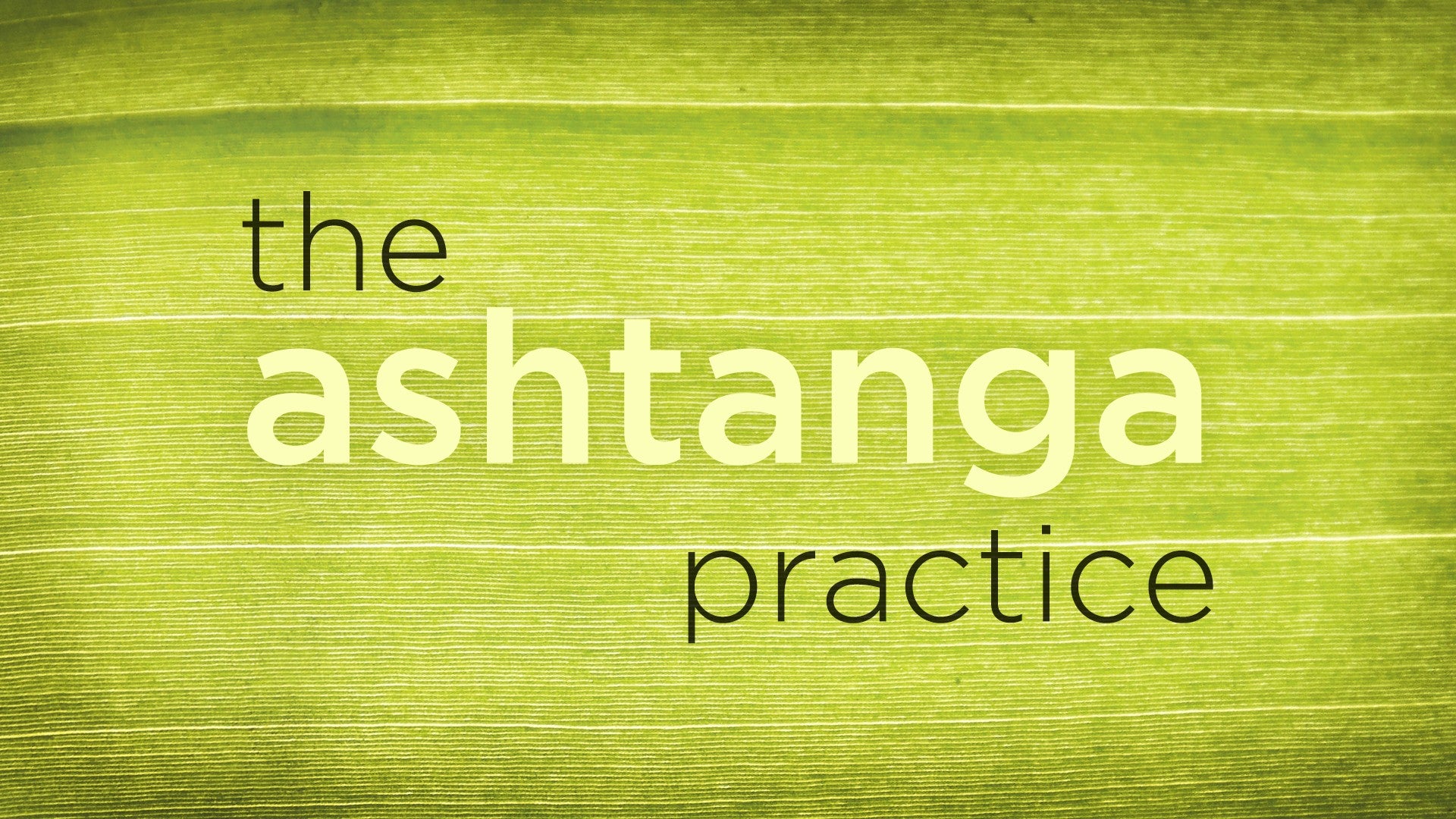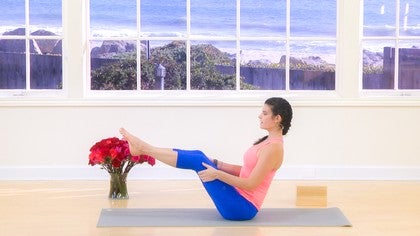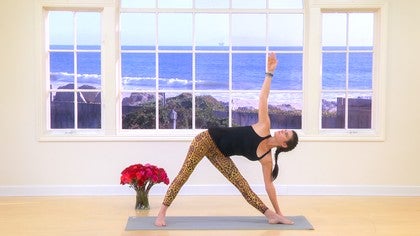Description
About This Video
Transcript
Read Full Transcript
(waves) In this session, we're gonna take a look at Navasana, which comes at right about the peak of the primary series. It's five postures that are exactly the same, they're done in order, one, two, three, four, five, like that, and it's some pretty serious core work. It's pretty serious work in the hamstrings and hip flexors, and it's also a really strong test of endurance. Because if you have just done the primary series, in an earlier session we were talking about the ashtanga practice as a sandwich. So now we've done the bread, we've done the condiments, we've done a little bit of the meat, the seated series, and now we're at that pickle that's underneath.
And you may love the pickle, you may hate the pickle, the pickle is there, we have to know how to do it. So you've done all of that, you've had that big, delicious sandwich, and you're probably really tired. I always am when I get to Navasana. So a couple of things to review before we get started; Bandhas (slurping sound) belly, breath. Your breath is going to relax you because you might, probably, at some point in your Navasana, feel a little bit stressed out.
Ujjayi. Uddiyana Bandha, the lower belly, and Mula Bandha, your pelvic floor, all work together to create this web of really strong lower abdominal muscles to help support your posture. Another thing that's really helpful in Navasana is your Drishti, which we'll talk about when we get there. And if you don't remember, Drishti is your gazing point. So where you fix your eyes.
So I'm gonna show you how you would transition into Navasana, and then we'll sort of look at it from a couple of different viewpoints. So Navasana comes after the primary series, after you've done a bunch of forward bends. A lot of Chaturanga, a lot of Up Dog, and you come into your Downward-Facing Dog. The Dog jumps into the Boat. Inhale, jump up, send your legs up, look at the toes, one, two, three, four, five.
Feet pull in, inhale lift. Exhale one, two, three (slurping sound), four, five. Inhale lift, so on and so forth. So that's Navasana, like a boat. We're sitting in front of the ocean.
It's not quite as relaxing as being on a boat, but it looks like a boat, and that's what you're going for: straight back, straight legs. It's hard. (laughs) It's really hard. So let's assume that my core is a little wobbly and that my legs are really tight, so my hamstrings are tight, my hip flexors are tight. So I'm gonna maybe not jump into my dog, but simply step up, or jump into my boat, rather. Step into my boat, put my hands behind my knees, and stay here.
So the Drishti is at your feet or at something in the distance like this. One, two, three, four, five. And then I pull my knees in like this, and I cross them and snuggle them in nice and tight, and I lift. And then exhale, one, two, three, four, five. So that's a really nice way to modify Navasana if you're feeling really tuckered out, you just can't quite get the legs to work with you in that particular posture.
Here's another way. I start as though I'm gonna move into modification one, like this, but then I'm feeling okay, I've got a little (slurping sound) here, the pelvic floor is engaging, pulling up, chest is lifting, and then maybe I just start to take the legs up just a little bit. They don't have to go all the way straight, but I can keep my hands here to help keep this lift in the chest. And I'm looking at my toes like I like them, kind of relaxed. And then I pull the knees in nice and tight, inhale up.
That's another way. The third way is if you feel here and here a big burning feeling, that is your hip flexors saying, "Please do something different. Change something." Your hip flexors are very, very important. We want to really listen to what they have to say. So maybe we put our hands here, lift in the chest, lift the legs, and then here you have lots of options with your legs. You can straighten, you can bend, and you can even go here, this is also a boat pose.
Just maybe not as assertive as this one. Now I'm gonna use my blocks. Traditionally in Ashtanga, you don't use props, but they are really helpful when you are learning. So there's this lift that comes in between each Navasana. Bandhas, belly in, pelvic floor stays in shape.
Those are really important because if I'm just using my upper body to lift my hips, this is what it will look like. It's not good. It's hard and it doesn't look pretty, and it's not efficient. So let's say that I need to bring the floor a little higher, so I'm gonna put my blocks like this, and I would recommend always keeping them at this flattened place. You can do this, I've seen people do this, but this is a little more wobbly.
This is fine. So I've done my Navasana, one, two, three, four, five, and then I'm pulling the feet in and as I pull in, I'm (slurping sound) drawing everything in. Inhale up, pelvic floor goes (slurping sound) up. We talked in a previous session about what level you want to stay activated in your Bandhas. When you're lifting in Navasana, when you're lifting in an arm balance, an inversion, you want to take the elevator up a notch, up a couple floors.
That is one way to modify. Let's say you don't have any blocks. I'll put them over here. You just put your hands on the floor and you pull your knees in, you look up, and you keep your feet on the floor and you lift your bum. And then you come back in to your Navasana.
Or you do the opposite. So the feet were on the floor when we were doing that one, now we're gonna lift the feet and pull them in, and just take the hands out like this. So in a moment, we're gonna transition back into our Chaturanga, and this is kind of like a prep for that because we're pulling everything in and we're just staying stabilized, and then we're back in Navasana. Nothing's changed. It's one breath; inhale up, exhale back to your Navasana for a count of five.
When we do Navasana, it is sometimes helpful to pull the fleshy bits away from your bum. Because we're not in a classroom right now with lots of people, and we're not so worried about pace and time, we can take a moment to do that, to get situated, and then we're gonna find our Navasana just like this, and then lean back a little bit so you fill out this space here (slurping sound) with the belly coming up. And if you can, just peek down at your belly. It's natural for the belly to push forward like a loaf of bread. It's not bad, it's not wrong, it doesn't mean anything about your body, it's just what it does.
When we're in Navasana, we wanna move the belly away from the shirt as you lift the chest. You can try that at home. Imagine this is a wall, and I'm gonna put my feet on my wall like this, and I'm gonna lay down, make sure I have some space. So if my feet were actually on a wall, they would be pushing into the wall like this. Because they're on a block, I'm gonna keep my legs really strong so they don't slide, and I'm gonna look at my belly.
As I come up, without doing any work, the belly pushes forward like a loaf of bread. That's just what it does. When I use my little, tiny, super powerful core muscles, the navel moves away from my shirt, it fills out, and I can find my Navasana. This is Navasana with no legs, with no hip flexors, no hamstrings, just core. You do that for the length of your favorite song every day, probably have a pretty strong boat.
If you don't do it every day, that's also fine. Your boat will still be good because you have lots of ways to practice. So I'm gonna put my blocks back over here, we don't need them anymore, and I'm gonna show you Navasana with a lift back to Chaturanga. So I'm in my Navasana, one, two, I'm looking at my feet, but not like a supermodel, just (exhales) Three, four, five. Feet come in, lifting up, and then I'm gonna jump back, so I'm pulling my feet in, putting my hands out in front of me, shoulders roll back, my gaze is forward, Chaturanga.
Inhale, Up Dog. Exhale, Downward-Facing Dog. From there, you move into lots of fun stuff, like arm balancing, lots of jumping back, jumping forward. Navasana is a good preparation for all of those postures, but take your time when you're in a class or when you're practicing at home, to really feel the work of your lower belly. Because the big muscles, these guys, will really wanna do the work for you, and those little muscles in here might feel a little bit left out.
These are the muscles that do the work of Navasana. These guys are the helpers. Chest lifts, belly in, hands back, knees bent, or knees straight, whatever works for you, as long as you stay connected to the breath, you stay connected to your practice. Thank you.
The Ashtanga Practice: Sarah Lowe
Comments

You need to be a subscriber to post a comment.
Please Log In or Create an Account to start your free trial.











